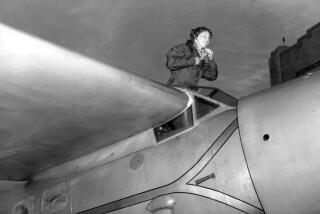U.S. Team in Fiji Hopes It’s on Trail of Amelia Earhart
- Share via
SUVA, Fiji — From the offices of the secret service to dusty hospital storerooms, some amateur sleuths are combing Fiji for a crate they speculate could contain the bones of aviation pioneer Amelia Earhart.
The American team, the latest to take a stab at solving the mystery of the U.S. aviator’s disappearance 62 years ago, has been given unprecedented access to most government buildings in the search.
But it has run into a snag in Fiji’s 78-year-old president, Ratu Sir Kamisese Mara.
Mara has denied the team permission to search his official residence, an imposing two-story mansion in Suva that the Americans hope contains clues to the whereabouts of the crate.
The mansion was formerly occupied by a succession of British colonial governors, one of whom ordered the recovery of bones that the searchers believe may be Earhart’s.
Earhart vanished in 1937 while attempting to become the first woman to fly around the world. Most authorities believe she and her navigator, Fred Noonan, lost their bearings, ran out of fuel and crashed into the Pacific while flying between New Guinea and Hawaii.
Some people have speculated that the two were captured on a Japanese-held island and executed as spies. The search team theorizes that the pair crash-landed and later died on Nikumaroro, an uninhabited atoll about 1,000 miles north of Suva that is now part of the tiny nation of Kiribati.
In 1940, a Fiji naval officer, Stanley Brown, found human bones on Nikumaroro.
Fiji’s governor, Sir Harry Luke, ordered the bones shipped to Suva, where a British physician concluded that the bones belonged to a man of European or mixed-race origin, and the bones were crated up for storage.
Experts who examined the doctor’s detail-filled report recently said they felt his measurements indicated that the skeleton was that of a white female of northern European background.
Richard Gillespie, a former aircraft accident investigator from Wilmington, Del., found the records of Dr. D.D. Hoodless’ examination of the bones in the Kiribati capital of Tarawa and in Britain.
The crate itself has vanished. The bones were last seen in 1941, together with a sextant box at the Suva offices of the Western Pacific High Commission.
The analyses of the report revived the search for the bones by the nonprofit International Group for Historic Aircraft Recovery, members of which have returned to Fiji and Nikumaroro.
“It’s a mystery that has puzzled people for 60 years, but this is the first time an actual scientific investigation is being carried out. It’s fascinating,” said Dr. Thomas King, a forensic anthropologist who is leading the team.
On the trail of the missing crate, the team has searched the offices of the Fiji Intelligence Service, the Fiji School of Medicine and other government buildings. The team members have interviewed retired doctors who may have had contact with the bones.
King is trying to persuade Mara to let the team look for records of the crate in the presidential mansion.
“If I were in his position, I’d be a little suspicious of people wanting to come in and search my house,” King said.
But he said he hoped Mara’s curiosity would be roused because the president was a medical student under Hoodless in 1940.
King said finding the bones would allow more extensive and thorough study than was available in Hoodless’ day, such as DNA tests.
King said $4 million has been spent so far on the hunt for the remains of the fliers and their aircraft.
Ten members of the International Group for Historic Aircraft Recovery visited Nikumaroro in July as part of preparations for a bigger expedition planned for 2000 to look for more bones and aircraft debris.
King said a recent trip turned up a heel of a shoe that he contends “matches the shoe in the photograph of Earhart getting out of the plane.”
More to Read
Sign up for Essential California
The most important California stories and recommendations in your inbox every morning.
You may occasionally receive promotional content from the Los Angeles Times.













